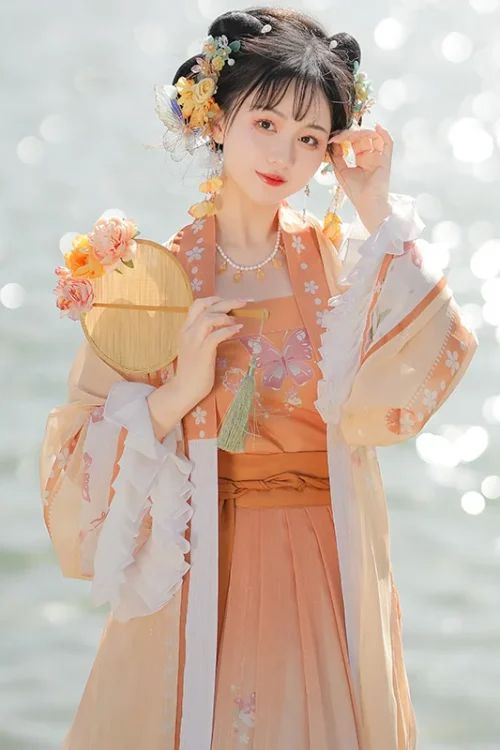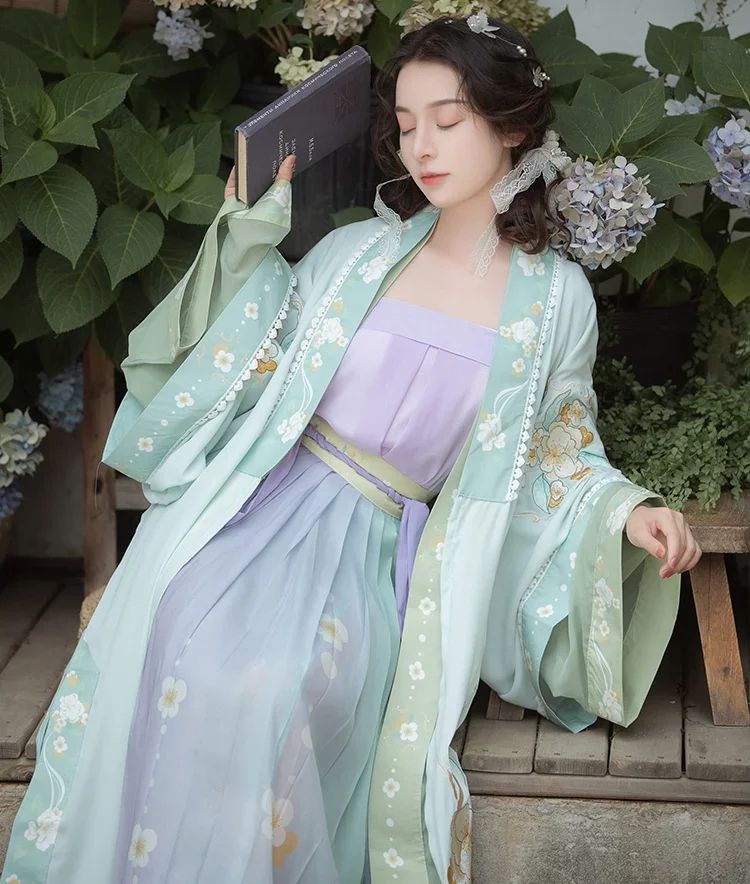The Evolution of Song Dynasty Hanfu: Tracing the Transformation of Women’s Fashion
A Shift in Aesthetic
During the Song Dynasty, hanfu, the traditional attire of China, underwent significant transformations, particularly in women’s fashion. The Song Dynasty hanfu for women embodied the ideals of feminine grace and modesty, reflecting the cultural values of the time.

Characteristics of Song Dynasty Hanfu
The Song Dynasty witnessed a shift towards a more refined and elegant aesthetic in hanfu. Women’s robes, known as ruqun, became longer and more flowing, with wider sleeves that allowed for graceful movements. The use of delicate fabrics, such as silk and gauze, added to the ethereal quality of the attire.
The Beizi Jacket
One of the most distinctive features of Song Dynasty hanfu was the use of the beizi, a type of jacket worn over the ruqun. The beizi typically featured intricate embroidery and embellishments, adding a touch of opulence to the ensemble. The length of the beizi varied, with some reaching down to the knees, while others were shorter and more fitted.
Accessories and Adornments
Another important aspect of Song Dynasty hanfu was the use of accessories. Women adorned themselves with a variety of jewelry, including necklaces, earrings, and bracelets. Hair accessories, such as hairpins and combs, were also popular and often featured elaborate designs.
Color Palette
The colors used in Song Dynasty hanfu were typically muted and understated, with a preference for shades of pink, blue, and green. These colors complemented the delicate fabrics and feminine silhouettes of the attire.
Lasting Influence
The Song Dynasty hanfu for women not only reflected the cultural values of the time but also influenced fashion trends in later periods. The emphasis on grace and modesty became a defining characteristic of Chinese women’s fashion, and the use of flowing fabrics and intricate embellishments continued to inspire designers for centuries to come.
Conclusion
In conclusion, the Song Dynasty hanfu for women was a testament to the feminine grace and modesty that were highly valued during that era. The flowing robes, delicate fabrics, and intricate accessories created an elegant and refined aesthetic that has left a lasting legacy in Chinese fashion history.
The Symbolism and Significance of Song Dynasty Hanfu: Unveiling the Cultural and Social Context
The Golden Age of Song Dynasty
The Song Dynasty (960-1279) marked a golden age in Chinese history, renowned for its cultural and artistic achievements. Among these, the hanfu reached its zenith of elegance and refinement. For women, the Song Dynasty hanfu embodied ideals of feminine grace and modesty, reflecting the social and cultural values of the time.

Layers of Meaning
The Song Dynasty hanfu for women consisted of several layers, each with its own significance. The innermost layer was the shan, a long, loose tunic that reached the ankles. Over the shan, women wore a ruqun, consisting of a skirt and a jacket. The skirt, known as the chang, was typically made of silk or cotton and featured intricate embroidery or patterns. The jacket, called the ao, was shorter than the skirt and often had wide sleeves.
The Outer Layer: Beizi
The outer layer of the hanfu was the beizi, a long, flowing robe that covered the entire body. The beizi was typically made of heavier fabrics, such as brocade or silk, and was often adorned with elaborate designs. The sleeves of the beizi were wide and flowing, adding to the overall sense of elegance and grace.
Symbolic Colors and Patterns
The colors and patterns used in Song Dynasty hanfu for women were also highly symbolic. Bright colors, such as red and yellow, were reserved for special occasions, while more subdued colors, such as blue and green, were worn for everyday activities. The patterns on the hanfu often depicted flowers, birds, and other natural motifs, reflecting the Song Dynasty’s appreciation for the beauty of nature.
Practical Functionality
In addition to its aesthetic appeal, the Song Dynasty hanfu for women also served a practical purpose. The loose, flowing layers allowed for freedom of movement, making it suitable for both indoor and outdoor activities. The wide sleeves of the beizi provided protection from the sun and wind, while the long skirt kept women warm in winter.
Reflection of Social Values
The Song Dynasty hanfu was a reflection of the social and cultural values of the time. The emphasis on modesty and grace mirrored the Confucian ideals that governed society during the Song Dynasty. Women were expected to be virtuous, demure, and respectful of their elders. The hanfu served as a physical manifestation of these values, reinforcing the social order and promoting harmony within the community.
Contemporary Relevance
Today, the Song Dynasty hanfu for women continues to be admired for its beauty and elegance. It is often worn during traditional festivals and cultural events, serving as a reminder of the rich cultural heritage of China. The hanfu also inspires contemporary fashion designers, who incorporate elements of its design into modern clothing, ensuring that the legacy of this timeless attire lives on.
The Practicality and Comfort of Song Dynasty Hanfu: Exploring the Functionality of Traditional Attire
A Testament to Cultural Values
The Song Dynasty (960-1279) marked a golden age in Chinese history, renowned for its cultural advancements and artistic achievements. Among the many cultural treasures that emerged during this period was the exquisite hanfu, the traditional attire of the Han Chinese people. For women, Song Dynasty hanfu embodied both feminine grace and modesty, reflecting the societal values and aesthetic sensibilities of the time.

Silhouette and Style
The silhouette of Song Dynasty hanfu for women was characterized by long, flowing robes that cascaded elegantly to the ground. These robes, known as ruqun, were typically made from fine silk or cotton and featured intricate embroidery or woven patterns. The robes were often layered, with a shorter, fitted undergarment called a yishan worn beneath a longer, looser outer robe called a beizi.
Color Choices
The colors of Song Dynasty hanfu for women were typically subdued and elegant, with shades of white, cream, pink, and blue being popular choices. These colors complemented the delicate embroidery and patterns that adorned the robes, creating a harmonious and visually appealing ensemble.
Design for Comfort
In addition to its aesthetic appeal, Song Dynasty hanfu for women was also designed with practicality and comfort in mind. The loose-fitting robes allowed for freedom of movement, making them suitable for everyday activities such as walking, working, and socializing. The layered construction of the robes also provided warmth during colder months, while the breathable fabrics ensured comfort in summer heat.
Distinctive Sleeves
The sleeves of Song Dynasty hanfu for women were another distinctive feature. They were typically long and wide, with a flared shape that added a touch of elegance and femininity to the overall look. The sleeves were often adorned with intricate embroidery or woven patterns, further enhancing the beauty of the attire.
Headwear Traditions
Headwear was an important part of Song Dynasty hanfu for women. Married women typically wore a type of headdress called a jiaozi, which was a rectangular piece of fabric folded into a triangular shape and secured with a hairpin. Unmarried women, on the other hand, wore their hair in elaborate hairstyles adorned with flowers, ribbons, and other decorative elements.
Enduring Symbol of Tradition
Overall, Song Dynasty hanfu for women was a testament to the refined taste and cultural values of the time. Its combination of feminine grace, modesty, and practicality made it an enduring symbol of Chinese tradition and artistry. Today, Song Dynasty hanfu continues to inspire contemporary fashion designers and enthusiasts, who appreciate its timeless beauty and cultural significance.
